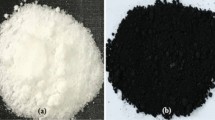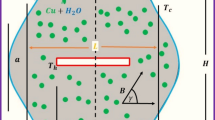Abstract
Hybrid nanofluids consisting of two or multiple nanoparticles have received much attention in recent decades. In this study, the rheological behavior of magnesium oxide (MgO) and graphene oxide (GO) nanoparticles which are dispersed in the water–ethylene glycol base fluid is investigated, experimentally, as a new hybrid nanofluid. The effect of volume fraction of nanoparticles (\(\varphi\)) and temperature on the thermal conductivity (\(k_{\text{nf}}\)) of the MgO–GO/water–ethylene glycol hybrid nanofluid is studied. The two correlations are presented for predicting the thermal conductivity. According to the results, the thermal conductivity increased by increasing the volume fraction and temperature. A maximum thermal conductivity improvement of 8.8% is obtained at \(\varphi =\) 0.2% and 60 °C. The margin of deviation of 0.507752 and 0.46812%, respectively, for the first and second correlations indicated the accuracy of the proposed correlations. At 20 °C, the relative thermal conductivity improves by 2.6%, and at 60 °C, the thermal conductivity improves by 5.4% compared to the base fluid. A comparison of the results obtained from these two correlations and experimental results with the theoretical approach (Lu–Lin model) indicated a significant difference between the results.











Similar content being viewed by others
References
Karimi-Maleh H, Ranjbari S, Tanhaei B, Ayati A, Orooji Y, Alizadeh M, Karimi F, Salmanpour S, Rouhi J, Sillanpää M, Sen F. Novel 1-Butyl-3-methylimidazolium bromide impregnated chitosan hydrogel beads nanostructure as an efficient nanobio-adsorbent for cationic dye removal: kinetic study. Environ Res. 2021;195:110809.
Orooji Y, Alizadeh A, Ghasali E, Deraldishandeh MR, Alizadeh M, Asl MS, Ebadzadeh T. Co-reinforcing of mullite-TiN-CNT composites with ZrB2 and TiB2 compounds. Ceram Int. 2019;45:20844–54.
Orooji Y, Ghasali E, Moradi M, Derakhshandeh MR, Alizadeh M, Asl MS, Ebadzadeh T. Preparation of mullite-TiB2-CNTs hybrid composite through spark plasma sintering. Ceram Int. 2019;45:16288–96.
Karimi-Maleh H, Orooji Y, Ayati A, Qanbari S, Tanhaei B, Karimi F, Alizadeh M, Rouhi J, Fu L, Sillanpää M. Recent advances in removal techniques of Cr(VI) toxic ion from aqueous solution: a comprehensive review. J Mol Liq. 2021;329:115062.
Orooji Y, Haddad Irani-Nezhad M, Hassandoost R, Khataee A, Rahim Pouran S, Joo SW. Cerium doped magnetite nanoparticles for highly sensitive detection of metronidazole via chemiluminescence assay. Spectrochim Acta A Mol Biomol Spectrosc. 2010;234:118272.
Mahdavi M, Sharifpur M, Meyer JP, Chen L. Thermal analysis of a nanofluid free jet impingement on a rotating disk using volume of fluid in combination with discrete modeling. Int J Therm Sci. 2020;158:106532.
Aghayari R, Maddah H, Pourkiaei SM, Ahmadi MH, et al. Experimental and theoretical studies of heat transfer in a double-pipe heat exchanger equipped with twisted tape and nanofluid. Eur Phys J Plus. 2020;135(2):252.
Ghasemi M, Khataee A, Gholami P, Soltani RDC, Hassani A, Orooji Y. In-situ electro-generation and activation of hydrogen peroxide using a CuFeNLDH-CNTs modified graphite cathode for degradation of cefazolin. J Environ Manage. 2020;267:110629.
Orooji Y, Ghanbari M, Amiri O, Salavati-Niasari M. Facile fabrication of silver iodide/graphitic carbon nitride nanocomposites by notable photo-catalytic performance through sunlight and antimicrobial activity. J Hazard Mater. 2020;389:122079.
Karimi-Maleh H, Kumar BG, Rajendran S, Qin JQ, Vadivel S, Durgalakshmi D, Gracia F, Soto-Moscoso M, Orooji Y, Karimi F. Tuning of metal oxides photocatalytic performance using Ag nanoparticles integration. J Mol Liq. 2020;314:113588.
Patel HE, Das SK, Sundararajan T. Thermal conductivities of naked and monolayer protected metal nanoparticle based nanofluids: manifestation of anomalous enhancement and chemical effects. Appl Phys Lett. 2003;83:2931–3.
Noie SH, Zeinali Heris S, Kahani M, Nowee SM. Heat transfer enhancement using Al2O3/water nanofluid in a two-phase closed thermosyphon‖. Int J Heat Fluid Flow. 2009;30:700–5.
Kleinstreuer C, Li J. Thermal performance of nanofluid flow in microchannels. Int J Heat Fluid Flow. 2008;29:1221–2123.
Vafaei M, Afrand M, Sina N, et al. Evaluation of thermal conductivity of MgO-MWCNTs/EG hybrid nanofluids based on experimental data by selecting optimal artificial neural networks. Phys E. 2017;85:90–6.
Zadkhast M, Toghraie D, Karimipour A. Developing a new correlation to estimate the thermal conductivity of MWCNT-CuO/water hybrid nanofluid via an experimental investigation. J Therm Anal Calorim. 2017;129:859–67.
Barnoon P, Toghraie D, Karimipour A. Application of rotating circular obstacles in improving ferrofluid heat transfer in an enclosure saturated with porous medium subjected to a magnetic field. J Therm Anal Calorim. 2020. https://doi.org/10.1007/s10973-020-09896-1.
Barnoon P, Toghraie D, Salarnia M, et al. Mixed thermomagnetic convection of ferrofluid in a porous cavity equipped with rotating cylinders: LTE and LTNE models. J Therm Anal Calorim. 2020. https://doi.org/10.1007/s10973-020-09866-7.
Harandi SS, Karimipour A, Afrand M, et al. An experimental study on thermal conductivity of F-MWCNTs–Fe3O4/EG hybrid nanofluid: effects of temperature and concentration. Int Comm Heat Mass Trans. 2016;76:171–7.
Hemmat M, Alirezaie A, Rejvani M. An applicable study on the thermal conductivity of SWCNT-MgO hybrid nanofluid and price-performance analysis for energy management. Appl Therm Eng. 2017;111:1202–10.
Hadadian M, Goharshadi E, Youssefi A. Electrical conductivity, thermal conductivity, and rheological properties of graphene oxide-based nanofluids. J Nano part Res. 2014;16:1–17.
Shahsavar A, Entezari S, Toghraie D, Barnoon P. Effects of the porous medium and water-silver biological nanofluid on the performance of a newly designed heat sink by using first and second laws of thermodynamics. Chines J Chem Eng. 2020;28:2928–37.
Hajjar Z, Morad Rashidi A, Ghozatloo A. Enhanced thermal conductivities of graphene oxide nanofluids. Int Comm Heat Mass Tran. 2014;57:128–31.
Yu W, Xie H, Chen W. Experimental investigation on thermal conductivity of nanofluids containing graphene oxide nanosheets. J Appl Phys. 2010;107:1–7.
Reddy MC, Rao VV. Experimental studies on thermal conductivity of blends of ethylene glycol-water-based TiO2 nanofluids. Int comm Heat Mass Trans. 2013;46:31–6.
Rai PK, Kumar A, Yadav A. Experimental investigation of heat transfer augmentation in automobile radiators using magnesium oxide/distilled water-ethylene glycol based nanofluid. Mater Today Proc. 2020;24:1525–32.
Akhgar A, Toghraie D, Sina N, Afrand M. Developing dissimilar artificial neural networks (ANNs) to prediction the thermal conductivity of MWCNT-TiO2/Water-ethylene glycol hybrid nanofluid. Powder Technol. 2019;355:602–10.
Choudhary S, Sachdeva A, Kumar P. Investigation of the stability of MgO nanofluid and its effect on the thermal performance of flat plate solar collector. Renew Energy. 2020;147:1801–14.
Moghadam IP, Afrand M, Hamad SM, et al. Curve-fitting on experimental data for predicting the thermal-conductivity of a new generated hybrid nanofluid of graphene oxide-titanium oxide/water. Phys A. 2020;548:122140.
Delisle CS, Welsford CA, Saghir MZ. Forced convection study with microporous channels and nanofluid: experimental and numerical. J Therm Anal Calorim. 2020;140:1205–14.
Le Ba T, Mahian O, Wongwises S, et al. Correction to: Review on the recent progress in the preparation and stability of graphene-based nanofluids. J Therm Anal Calorim. 2020;142:1173–81.
Monfared RH, Niknejadi M, Toghraie D, et al. Numerical investigation of swirling flow and heat transfer of a nanofluid in a tube with helical ribs using a two-phase model. J Therm Anal Calorim. 2021. https://doi.org/10.1007/s10973-021-10661-1.
Michael Joseph Stalin P, Arjunan TV, Matheswaran MM, et al. Experimental and theoretical investigation on the effects of lower concentration CeO2/water nanofluid in flat-plate solar collector. J Therm Anal Calorim. 2019;135:9–44.
Plant RD, Hodgson GK, Impellizzeri S, et al. Experimental and numerical investigation of heat enhancement using a hybrid nanofluid of copper oxide/alumina nanoparticles in water. J Therm Anal Calorim. 2020;141:1951–68.
Hemmat Esfe M, Bahiraei M, Torabi A, Valadkhani M. A critical review on pulsating flow in conventional fluids and nanofluids: thermo-hydraulic characteristics. Int Comm in Heat and Mass Trans. 2020;120:104859.
Yan SR, Toghraie D, Abdulkareem LA, Alizadeh A, et al. The rheological behavior of MWCNTs–ZnO/Water–Ethylene glycol hybrid non-Newtonian nanofluid by using of an experimental investigation. J Mat Res Technol. 2020;9:8401–6.
Freitas C, Müller RH. Effect of light and temperature on zeta potential and physical stability in solid lipid nanoparticle (SLN™) dispersions. Int J pharmaceutics. 1998;168:221–9.
A.F. Handbook, American society of heating, refrigerating and air-conditioning engineers, Inc.: Atlanta, GA, USA, 2009
Khanafer K, Vafai K. A critical synthesis of thermophysical characteristics of nanofluids. Int J Heat Mass Trans. 2011;54(19):4410–28.
Author information
Authors and Affiliations
Corresponding author
Additional information
Publisher's Note
Springer Nature remains neutral with regard to jurisdictional claims in published maps and institutional affiliations.
Rights and permissions
About this article
Cite this article
Roohani, E., Toghraie, D. Heat transfer improvement of antifreeze by changing it to hybrid nanofluid: effects of hybrid magnesium oxide–graphene oxide nanopowders. J Therm Anal Calorim 147, 6777–6791 (2022). https://doi.org/10.1007/s10973-021-10973-2
Received:
Accepted:
Published:
Issue Date:
DOI: https://doi.org/10.1007/s10973-021-10973-2




